冀教版初中英语七年级上册Lesson 13 Body Partsword教案 (2)
冀教版-英语-七上-教案3单元 第13课 Body Parts
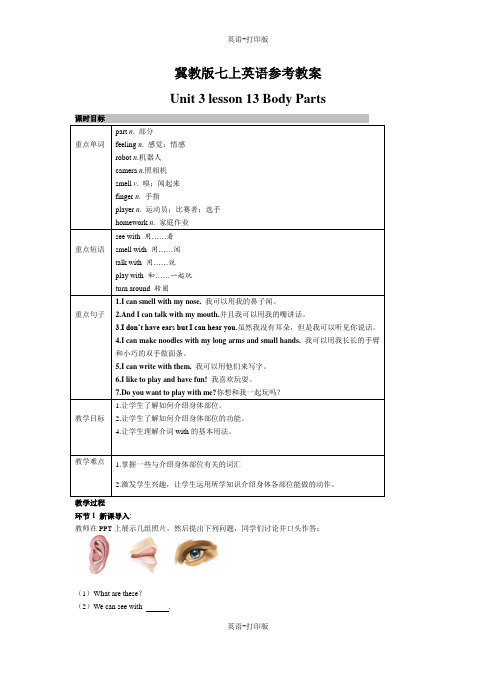
冀教版七上英语参考教案Unit 3 lesson 13 Body Parts 课时目标重点单词 part n . 部分 feeling n . 感觉;情感robot n .机器人camera n .照相机smell v . 嗅;闻起来finger n . 手指player n . 运动员;比赛者;选手homework n . 家庭作业重点短语 see with 用……看 smell with 用……闻talk with 用……说play with 和……一起玩turn around 转圈重点句子 1.I can smell with my nose. 我可以用我的鼻子闻。
2.And I can talk with my mouth.并且我可以用我的嘴讲话。
3.I don’t have ears but I can hear you.虽然我没有耳朵,但是我可以听见你说话。
4.I can make noodles with my long arms and small hands. 我可以用我长长的手臂和小巧的双手做面条。
5.I can write with them. 我可以用他们来写字。
6.I like to play and have fun! 我喜欢玩耍。
7.Do you want to play with me?你想和我一起玩吗?教学目标1.让学生了解如何介绍身体部位。
2.让学生了解如何介绍身体部位的功能。
4.让学生理解介词with 的基本用法。
教学难点 1.掌握一些与介绍身体部位有关的词汇2.激发学生兴趣,让学生运用所学知识介绍身体各部位能做的动作。
教学过程环节1 新课导入:教师在PPT 上展示几组照片,然后提出下列问题,同学们讨论并口头作答:(1)What are these ?(2)We can see with .(3)we can hear with .设计意图:通过图片展示更加直观地呈现本课时的主题:body parts。
【冀教版】七年级上册:Unit 3《Body Parts and Feelings》全单元教案【精校版】
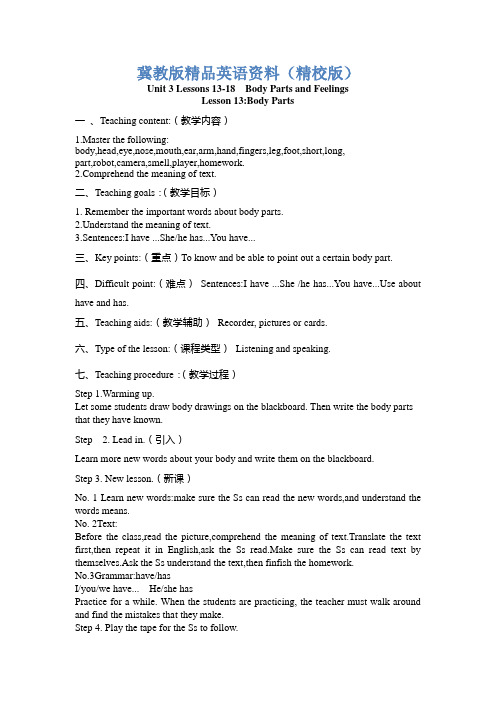
冀教版精品英语资料(精校版)Unit 3 Lessons 13-18 Body Parts and FeelingsLesson 13:Body Parts一、Teaching content:(教学内容)1.Master the following:body,head,eye,nose,mouth,ear,arm,hand,fingers,leg,foot,short,long,part,robot,camera,smell,player,homework.prehend the meaning of text.二、Teaching goals:(教学目标)1. Remember the important words about body parts.2.Understand the meaning of text.3.Sentences:I have ...She/he has...You have...三、Key points:(重点)To know and be able to point out a certain body part.四、Difficult point:(难点)Sentences:I have ...She /he has...You e about have and has.五、Teaching aids:(教学辅助)Recorder, pictures or cards.六、Type of the lesson:(课程类型)Listening and speaking.七、Teaching procedure:(教学过程)Step 1.Warming up.Let some students draw body drawings on the blackboard. Then write the body parts that they have known.Step 2. Lead in.(引入)Learn more new words about your body and write them on the blackboard.Step 3. New lesson.(新课)No. 1 Learn new words:make sure the Ss can read the new words,and understand the words means.No. 2Text:Before the class,read the picture,comprehend the meaning of text.Translate the text first,then repeat it in English,ask the Ss read.Make sure the Ss can read text by themselves.Ask the Ss understand the text,then finfish the homework.No.3Grammar:have/hasI/you/we have... He/she hasPractice for a while. When the students are practicing, the teacher must walk around and find the mistakes that they make.Step 4. Play the tape for the Ss to follow.Step 5.Summary. (小结)Sum up the body parts,distinction have and has how to use it.Step 6. Homework.(作业)Do your excise book.Step 7.Blackboard-writing:(板书)八.Teaching reflection:(教后反思)Lesson 14:Colors and Feelings一、Teaching content:(教学内容)1.To master these words:sad, sick, scared, angry. To understand the following:question.smile,mean.2. some useful patterns:How can you feel a color? Don't be scared!二、Teaching goals:(教学目标)1.to learn how to express the feelings .2.to learn more about the colors.3.to use what was learned in the daily life三、Key points:(重点)The words about feelings: sad, sick, scared, angry.四、Difficult point:(难点)What colors stand for what feelings.五、Teaching aids:(教学辅助)Recorder, pictures or cards.六、Type of the lesson:(课程类型)Listening and speaking.七、Teaching procedure:(教学过程)Step 1.Warming up.Review the words about colors.Step 2. Lead in.(引入)Ask the students questions in the life. You give a student a present and ask his feeling now. Then lead the words:happy, sad, sick, scared, angry.Step 3. New lesson.(新课)No. 1 I feel blue.Li Ming:Hi,Jenny!I am listening to an English song.In the song,the singer says "I feel blue".How can you feel a color?Jenny:That's a good questions.In English,we use many colors for our feelings.Blue can mean "sad".Green can mean "sick".Yellow can mean "scared".And red can mean "angry".Li Ming:Wow!Thank you,Jenny.In China,red is a happy color.No. 2 Sentences:Don't feel bad.Don't be scared.Don't see red.Don't feel sick.Step 4. Play the tape for the Ss to follow.Step 5.Summary. (小结)Sum up the words about feelings,and what colors for what feelings.Step 6. Homework.(作业)Finish the activity book.Step 7.Blackboard-writing:(板书)The words about feelings.八.Teaching reflection:(教后反思)Lesson 15:Tall or Short一、Teaching content:(教学内容)1.master these new words: tall,short.2.to understand these words: Meter, stand, on3. the in-structures : How tall are you? I’m 1.6 meters tall.二、Teaching goals:(教学目标)1.to be able to ask about one’s hight.2.ask the students to do active practice3.Sentences:How tall are you? How tall is she/he?三、Key points:(重点)1.how to say one’s height in English.2.to be able to read the text in the correct tones with the perfect pronunciation.四、Difficult point:(难点)How to read out “3.1 meters , 1.6 meters”. (plural forms of nouns)五、Teaching aids:(教学辅助)Recorder, pictures or cards.六、Type of the lesson:(课程类型)Listening and speaking.七、Teaching procedure:(教学过程)Step 1.Warming up.Learn new word:tall,short,meter,stand ,against,tail,flat,upon,ground.Step 2. Lead in.(引入)Introduce the text first in Chinese,then ask the Ss read the pictures,answer the questions.Step 3. New lesson.(新课)No. 1 Presentationa ruler or some other things while can be used to measure the length, the height, and so on.No. 2 Practice telling one heightAsk the students :1. How tall are you?2. How tall is she/he?3. How tall is your teacher?4. How tall is your friend?Talk about the partner about the subject. Then ask volunteers to come to the front to act the dialogue out.Step 4. Play the tape for the Ss to follow.Step 5.Summary. (小结)Practice the dialogue . Let some students act it out.Step 6. Homework.(作业)Finish the activity book.Step 7.Blackboard-writing:(板书)The important words.八.Teaching reflection:(教后反思)Lesson 16:Happy or Sad一、Teaching content:(教学内容)1.To master these words:happy, sad.To understand the following:very, tired,enough.2. some useful patterns:How do you feel? I feel happy! I’m NOT fine, thanks. Are you tired? No, I’m not. I just feel sad.二、Teaching goals:(教学目标)1.to learn how to express the feeling of sad and happy.2.to learn more about the feelings.3.to use what was learned in the daily life.三、Key points:(重点)How do you feel? I feel happy! I’m NOT fine, thanks. Are you tired? No, I’m not. I just feel sad.四、Difficult point:(难点)Practice the dialogue.五、Teaching aids:(教学辅助)Recorder, pictures or cards.六、Type of the lesson:(课程类型)Listening and speaking.七、Teaching procedure:(教学过程)Step 1.Warming up.Ask the students questions in the life. You give a student a present and ask his feeling now. Then lead the words: happy, sad.Step 2. Lead in.(引入)Before the class,make the Ss understand the followingquestions:1.How does Jenny feel?2.Is Danny hurt?3.Is Danny tired?Step 3. New lesson.(新课)No. 1 Give the presents that you prepared to the s tudents that do well. Then ask “How do you feel?” Explain it in Chinese when it is necessary. Help them answer “I’m happy.” Then take their presents away and ask “How do you feel now?” Help them answer “I’m sad”No. 2Begin “happy, sad” game in pairs, using the presents that we prepared before the class. The best one will get a present.Let’s sing a song together. Listen to the tape and sing happily after it. Encourage students to sing loudly because what we need is a happy feeling. The students can stand up and do according to the text.Step 4. Play the tape for the Ss to follow.Step 5.Summary. (小结)Sum up sentences:How do you feel?Step 6. Homework.(作业)Finish the activity book.Step 7.Blackboard-writing:(板书)八.Teaching reflection:(教后反思)Lesson 17:Seeing a Doctor一、Teaching content:(教学内容)Master these new words and expressions: How do you feel? hurt,stomachache,headache,medicine,have a good rest,see a doctor,have a cold,what's the matter?二、Teaching goals:(教学目标)1.Encourage students to express the uncomfortable feeling.2.Practice the sentences go on:How do you feel? What’s the matter?3.Understand the meaning of text and practice the dialogue.三、Key points:(重点)Help students grasp the expressions to ask and answer the uncomfortable feeling. 四、Difficult point:(难点)Learn the key sentence: What’s the matter? ___ hurt(s). I have a -ache.五、Teaching aids:(教学辅助)Recorder, pictures or cards.六、Type of the lesson:(课程类型)Listening and speaking.七、Teaching procedure:(教学过程)Step 1.Warming up.Let some students draw body drawings on the blackboard. Then write the body parts that they have known.Step 2. Lead in.(引入)Learn more new words about your body and write them on the blackboard.Step 3. New lesson.(新课)No. 1 PresentationListen and repeat the new words. Because some words are hard, we listen and repeat for several times until we can read the words correctly.Point to parts of your body as you and the class say the words.No. 2 Dialogue:1 Are you OK?Jenny:How do you feel,Jim? Are you OK?Jim:See my arm?It hurts.Jenny:It looks bad!Let's go and see a doctor.2.You have a cold.Dr.Green:Hi,Danny.What's the matter?Danny:I feel sick.I have a headache.Dr.Green:Do you feel cold?Danny:Yes!I feel very cold.Dr.Green:Well,let me see...You have a cold.Take this medicine.Stay home and have a good rest.Danny:OK.Thank you ,Doctor Green.Step 4. Play the tape for the Ss to follow.Step 5.Summary. (小结)Sum up the phrases:How do you feel? have a good rest,see a doctor,have a cold,what's the matter?You'd better...Step 6. Homework.(作业)Finish the activity book.Step 7.Blackboard-writing:(板书)The useful phrase.八.Teaching reflection:(教后反思)Lesson 18:We All Look Different一、Teaching content:(教学内容)1.master these new words:hair, has.2.learn and understand these words:different,blond.eful instructions : What does he/she look like? She /he has long/short hair. I have short hair.二、Teaching goals:(教学目标)1.learn to describe the looking of oneself and other students.2.to be able to read the text fluently.3.to write a short passage in English, describe oneself or other people.三、Key points:(重点)How to describe one’s hair, including the length and the color.四、Difficult point:(难点)The verb should be in a special form, such as have and has.五、Teaching aids:(教学辅助)Recorder, pictures or cards.六、Type of the lesson:(课程类型)Listening and speaking.七、Teaching procedure:(教学过程)Step 1.Warming up.Review: Express the feelings of yourself. You can say like this: Are you OK? How do you feel? Let some students answer and ask questions like this.Step 2. Lead in.(引入)Introduce the text in Chinese first.Learn to describe the looking of oneself and other students.Step 3. New lesson.(新课)No. 1 What does he/she look like?(describe people)She is beautiful.He is good-looking.He looks cool!She looks cute!No. 2 We all look different.(have/has)She has short blond hair.He has three black hair.I have short black hair.Step 4. Play the tape for the Ss to follow.Step 5.Summary. (小结)Sentences: What does he/she look like? She /he has long/short hair. I have short hair.Step 6. Homework.(作业)Come to the activity book.Step 7.Blackboard-writing:(板书)The master words.八.Teaching reflection:(教后反思)Unit Review一、Teaching content:(教学内容)1.Words and phrases .2.Key sentences .二、Teaching goals:(教学目标)1. Enable students to use the words and the expressions learned freely.2.Help students grasp the expressions in their daily life.三、Key points:(重点)The words and the expressions in this unit.四、Difficult point:(难点)How to use “have” and “has”.五、Teaching aids:(教学辅助)Recorder, pictures or cards.六、Type of the lesson:(课程类型)Review.七、Teaching procedure:(教学过程)Step 1.Warming up.Review words and expressions in this unit .Step 2. Task:No. 1 Building your vocabulary.Finish the excise on page 46 for remembering more word.No. 2 Grammar in use.(have/has)Practice:Fill in the blanks with have/has.1.May I a pencil,Jenny?2.Danny many yellow shirts.3.You a cold.You'd better go and see a doctor.4.She feels sick.She a stomachache.Step 3. Play the tape for the Ss to follow.Then finish the homework.Step 4.Summary. (小结)Sum up the phrases:play with,listen to,wave one's hand,see red,How tall is she/he? How tall are you? a bit,How do you feel?What's wrong?What's the matter?See a doctor.Are you OK? I have a headache.You'd better ... Have a cold.stay home.have a rest. What does he/she look like? Look different.look cool/cute/funny.Step 5. Homework.(作业)Finish the excises book.Step 6.Blackboard-writing:(板书)Grammar.八.Teaching reflection:(教后反思)。
冀教版七年级英语上册 Lesson13 【优质教案】
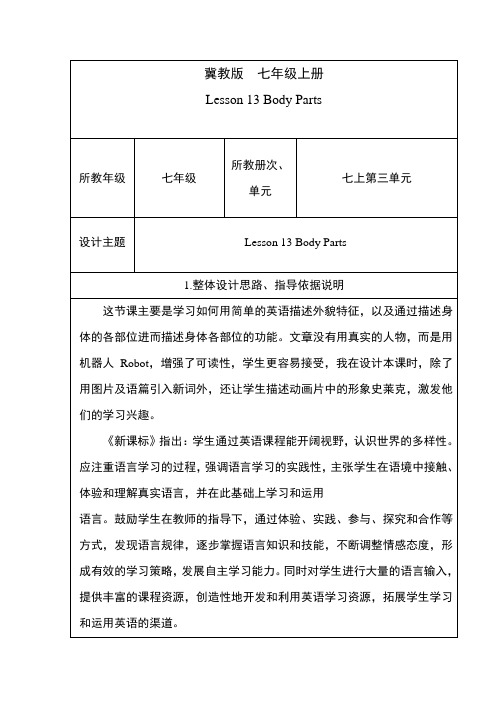
Take your right hand out.
Put your right hand in,
And shake it all about.
Do the Hokey Pokey, And turn around. That’s what it’s all about.
Step 3 Learn the new words.
Show the students some pictures and sentences and help them to grasp the new words.
(设计意图:通过图片展示新词,突出重点,突破难点;通过语篇进行解释,使学生利用语境记单词和短语的含义。)
[设计思路:通过唱歌、动作,培养学生的口、手、脚的协调能力,巩固新知。]
Step 10 Dig in
1. Eye for eye and tooth for tooth.以牙还牙,以眼还眼。
2. He has a green thumb.他有特殊的园艺才能。
3. Tom likes to talk with others face to face.汤姆喜欢面对面地与别人交谈。
Greet the students
Step 2 Warm-up: Brainstorm:
Write down as many words about body part and actions as they can. (写出关于身体部位、动作的词汇)
[设计思路:利用头脑风暴让学生以最短的时间写出关于身体部位和动作的词汇,利于后面的新知学习。]
7.教学反思
本课的教学调动了学生的多种感官,让学生动口、动手、动脑,使不同学习类型的学生都有所收获。再通过头脑风暴、小组活动、猜谜游戏、歌曲等活动激发了学生的学习兴趣,拓展了学生的知识面。
冀教版英语七年级上册Unit3 Lesson13 Body parts课件

taste
意为“尝起来”, 表示通过味觉感受到的
The food tastes good. 这食物尝起来不错。(吃过)
易混辨析 speak,say,talk与tell
一般指“说某种语言”或者“与某 May I s说话吗?
意为“说……;说话”,作及物动 He said nothing to me about it.
Lead in Write down as many body part as you can.
head
eye
hair
mouth
face
ear arm hand
leg
nose thumb finger
foot
Lead in Write the plural forms of the words.
Practice
Read and Say.
This is a robot. His name is Robin. He has … He can …with his ...
知识讲解
like 的用法
like /laɪk/ prep. 像;像……一样
eg:Like father, like son. You're also good at basketball. 有其父必有其子,你也擅长打篮球。
固定短语: at the foot of 在……的脚下 on foot 步行
知识讲解
固定短语play with
play with 和……一起玩
eg:I often play with my friends. 我经常和我的朋友们一起玩。
固定短语: (1)play with sb. 和某人一起玩
eg:Do you want to play with me? 你想和我一起玩吗? (2)play with sth. 玩某物
Unit3Lesson13BodyParts教案冀教版英语七年级上册

Unit 3 Body Parts and FeelingsLesson13 Body Parts教学目标b.And I can talk with .my mouth.c.I can speak Chinese and English.d.I don't have ears but I can hear you.e.Do you want to play with you?f. And turn around.教学过程Warm upeyemouthnoseearhandfootThink about these questions before reading the text.1. What can Robin do with its eyes?2. Can Robin speak Chinese?3. Can Robin make noodles?Also位于句中,放在系动词、助动词、情态动词之后,实义动词之前。
too位于句末,用逗号跟前面的句子隔开。
I can smell with my nose.smellv. 嗅;闻起来smell with …用……闻smell表示“闻起来”时,用作感官动词,后接形容词作表语。
e.g.The apple smells sweet.talkv. 谈论talk to sb. 对……谈话talk with sb. 和……交谈在该句话中,with表示使用某身体部位。
talk强调“谈论”,后接宾语时,要使用介词to/with。
speak强调“使用某种语言”,也可用于用语中。
I have ten fingers —— just like you.likeprep. 像该词还可用作动词,意为“喜欢”e.g.I like to go swimming.fingern. 手指1)我的长胳膊________ 2)十个手指__________3)两个长腿__________ 4)两个大脚__________5)我的小手__________ 6)喜欢玩 ___________ 7)玩的开心_________ 8)和我玩 ___________9)为你做面条__________________10)做我的家庭作业 ______________Task 2 小组合作,在文中找出下列句子I have two eyes.I can see with them.I have a nose and a mouth.I can smell with my nose and I can talk with my mouth.I can make noodles with my long arms and small hands.I have ten fingers.I can write with them.I have two long legs and two big feet.I am a good football player.1. I have two big ____. I can ___ with them.2. I have one nose and one _______.I can _____ with my nose.And I can _____with my mouth.3. I don’t have _______, but I can _____ you.4. I can make noodles with my long arms and small________.5. I have two long ______and two big feet.I’m a good football______.1. Robin is a good basketball player. (T) / ( F )2. Robin can speak English and ________ .3. Robin can help Danny _______ .Can Robin speak Chinese?How many fingers does Robin have?Can Robin play football?。
冀教版英语七年级上册Lesson13Body Parts第一课时教案详解

冀教版英语七年级上册Lesson 13:Body Parts第一课时教案详解教学目标1.掌握单词:part,feeling,robot,camera,smell,finger,player,homework短语:make noodles,play with,do one’s homework,etc.2.掌握和运用描述身体部位及其功能的句型:I have two big eyes.I can see with them.They are also my cameras.I have one nose and one mouth.I can smell with my nose.And I can talk with my mouth.I can speak English and Chinese.I don’t have ears but I can hear you.Can you do my homework for me,Robin?3.能使用动词have。
4.通过观察机器人的外部构造,会用英语说出身体部位的名称。
5.在小组活动中,积极与他人合作,互相帮助,体会英语学习中的乐趣,遇到困难时,能主动请教,勇于克服困难。
教学内容1.学会运用表示身体部位及其功能的词或短语:part,feeling,robot,camera,smell,finger,player,homework,make noodles,play with,do one’s homework。
2.学会描述身体部位及其功能的句型:I have two big eyes.I can see with them.They are also my cameras.I have one nose and one mouth.I can smell with my nose.And I can talk with my mouth.I can speak English and Chinese.I don’t have ears but I can hear you.Can you do my homework for me,Robin?3.学会描述自己的身体部位:I have…4.学会使用情态动词can的肯定句、一般疑问句和否定句。
冀教版七年级英语上册Lesson13BodyParts优质教案(1)
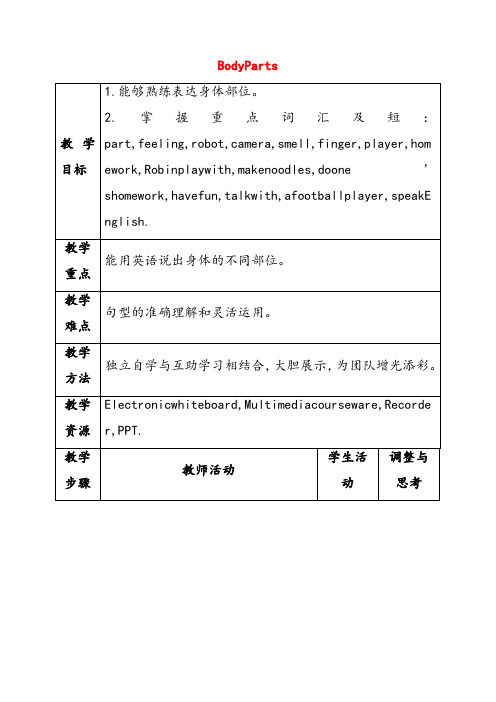
(1)此句式的用法:你是否了解呢?这是请求帮助时的用语。其中can是情态动词,后接动词原形,意为“能”。肯定回答常用:Sure!/Ofcourse!否定回答为:Sorry!Ican’t.等回答。
一Canyouhelpme?你能帮我吗?
一Sorry,Ican’t.Imustdothisfirst.对不起,我不能帮你。我得先做这件事。
Pairworkandcheckeachother
Learnandfinishtheexercisesingroups
Answerinpairs
Self-learningandsummary
Haveaexamandconsolidation
作业
Readthetextfluently.
Dosomesentencepatterntransformation.
板
书
设
计
Lesson13BodyParts
Languagepoints:
Iwanttomakea cardforMumforherbirthday.
=IwanttomakeMuma cardforherbirthday.
教
学
反
思
教学重点
能用英语说出身体的不同部位。
教学难点
句型的准确理解和灵活运用。
教学方法
独立自学与互助学习相结合,大胆展示,为团队增光添彩。
教学资源
Electronicwhiteboard,Multimediacourseware,Recorder,PPT.
教学步骤
教师活动
学生活动
调整与思考
教
学
过
程
设
计
冀教版(河北)七年级英语上册课件:Lesson 13 Body Parts(共13张PPT)

和功能。 • 【教学难点】have的简单运用。
Presentation
Hello! My name is Robin. I am a robot.
n. 机器人
Presentation
I have two big eyes. I can see with ቤተ መጻሕፍቲ ባይዱhem. They are also my cameras.
Unit 3
Body Parts and Feelings
Lesson 13:
Body Parts
Objective
Objectives 教学目标
• 1.掌握重点单词:(预习中掌握 :part,feeling,robot camera, smell, finger, player, homework。)
Presentation
I have two long legs and two big feet. I'm a good football player.
n. 比赛者;选手
Presentation
I like to play and have fun! Do you want to play with me? We can be friends!
七年级英语上册《Lesson 13 Body Parts》学案(无答案) 冀教版
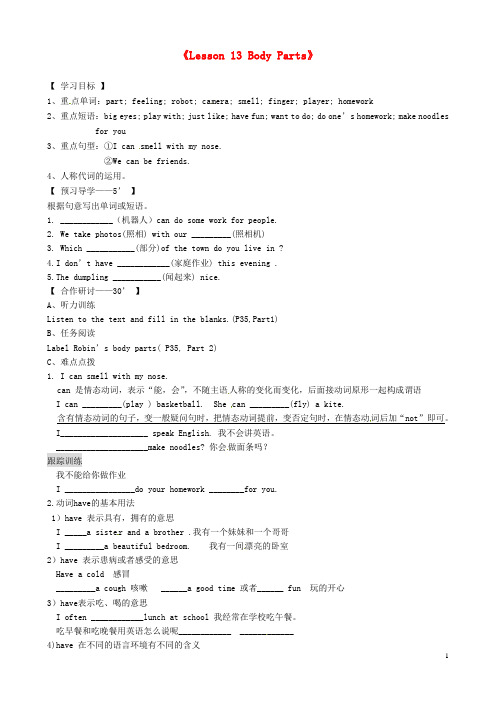
《Lesson 13 Body Parts》【学习目标】1、重点单词:part; feeling; robot; camera; smell; finger; player; homework2、重点短语:big eyes; play with; just like; have fun; want to do; do one’s homework; make noodlesfor you3、重点句型:①I can smell with my nose.②We can be friends.4、人称代词的运用。
【预习导学——5’】根据句意写出单词或短语。
1. ____________(机器人)can do some work for people.2. We take photos(照相) with our _________(照相机)3. Which ___________(部分)of the town do you live in ?4.I don’t have ____________(家庭作业) this evening .5.The dumpling ___________(闻起来) nice.【合作研讨——30’】A、听力训练Listen to the text and fill in the blanks.(P35,Part1)B、任务阅读Label Robin’s body parts( P35, Part 2)C、难点点拨1. I can smell with my nose.can 是情态动词,表示“能,会”,不随主语人称的变化而变化,后面接动词原形一起构成谓语I can _________(play ) basketball. She can _________(fly) a kite.含有情态动词的句子,变一般疑问句时,把情态动词提前,变否定句时,在情态动词后加“not”即可。
冀教版七年级英语(上册)Unit3Lesson13BodyParts-教案设计
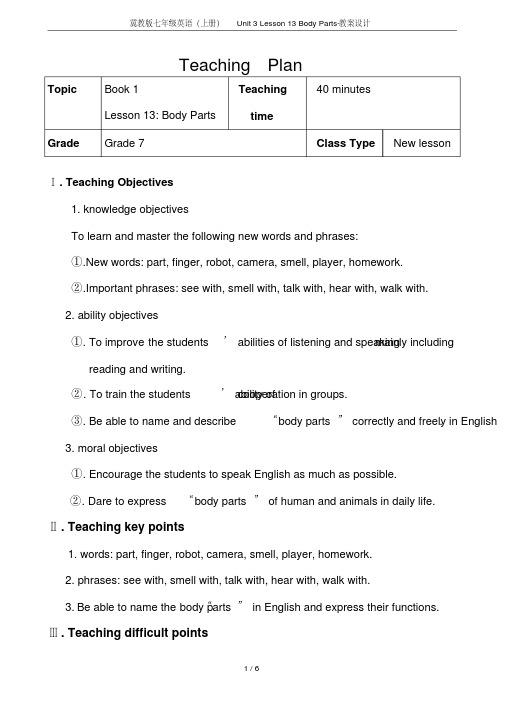
1. video, flash card, pictures, power point
Ⅵ . Teaching procedures
Step1. Warming up and lead in
①.Greet the students.
T: Hi, boys and girls.
Ss: …
T: Great. This class, I
2/6
冀教版七年级英语(上册) Unit 3 Lesson 13 Body Parts-教案设计
some questions. If your answer is right, I will give you a star ( Look here, here are
some starts, show the starts to the Ss). At the same time, you choose a leader. At last,
Ss: Eyes.
T: What ’s this?
Ss: Mouth.
…
T: All of these are body parts. So, Today, We will learn
“Lesson 13: Body
(设计意图:通过和学生之间的热身活动,调节课堂气氛。通过为学生分组比
冀教版七年级英语(上册) Unit 3 Lesson 13 Body Parts-教案设计
Topic Grade
Book 1
Teaching Plan
Teaching
40 minutes
Lesson 13: Body Parts
time
Grade 7
Class Type New lesson
陕西省汉中市实验中学冀教版七年级英语上册教案:Lesson13BodyParts
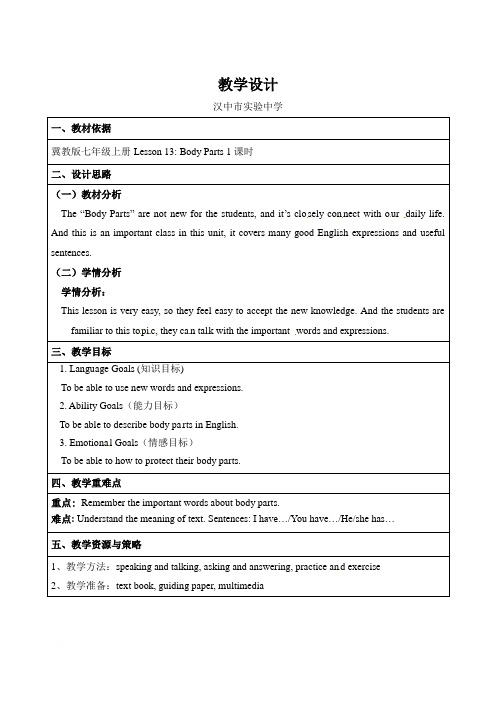
教学设计汉中市实验中学一、教材依据冀教版七年级上册Lesson 13: Body Parts 1课时二、设计思路(一)教材分析The “Body Parts” are not new for the students, and it’s clo sely con nect with o ur daily life. And this is an important class in this unit, it covers many good English expressions and useful sentences.(二)学情分析学情分析:This lesson is very easy, so they feel easy to accept the new knowledge. And the students are familiar to this topi c, they ca n talk with the important words and expressions.三、教学目标1. Language Goals (知识目标)To be able to use new words and expressions.2. Ability Goals(能力目标)To be able to describe body pa rts in English.3. Emotional Goals(情感目标)To be able to how to protect their body parts.四、教学重难点重点: Remember the important words about body parts.难点: Understand the meaning of text. Sentences: I have…/You have…/He/she has…五、教学资源与策略1、教学方法:speaking and talking, asking and answering, practice an d exercise2、教学准备:text book, guiding paper, multimedia五、教学过程教学环节教师活动学生活动设计意图Step 1 Lead-in Listen to an Engli sh song to leadto the new lesson.Sing the song and dosome actionsDraw students’attention.Step 2 Learning Objectives Show the learning objectives. Read aloud together. Make studentsknow what theywill learn in thislesson.Step 3 Listening 1. Give questions before listening.2. Listen to the tape together.Li sten and answer thequestions.Improve theirs kills of solvingproblems.Step 4 Reading 1. Give questions before reading.2. Read the text together andanswer the questions.Read and answer thequestions.Improve theirreading skills.Step 5 Exercise Let students introduce their bodyparts with phrases“I have…;He/shehas…”Introduce their bodyparts with the correctsentence patternsOutput partStep 6 Guessing Game 1. Show picture of a student, pointhis b ody parts and let th em guesswho is he.2. Finish the exercise 3 on Page37.Finish the guessinggame.Arousing theirinterests of bodypartsStep 7HomeworkFinish English Weekly of Lesson 13.六、板书设计。
冀教版七年级上册英语Unit 3 Lesson 13 Body Parts 授课课件

4.
ears
hear
Icanmakenoodleswithmylongarmsand________hands. small
Ihavetwolonglegsandtwobigfeet.
I'magoodfootball________.
player
听力材料
Hello! MynameisRobin. Iamarobot. Ihavetwobigeyes. Icanseewiththem. Theyarealsomycameras. Ihaveonenoseandonemouth. Icansmellwithmynose. And Icantalkwithmymouth. IcanspeakEnglishandChinese! Idon’thaveearsbutIcanhearyou. Icanmakenoodleswithmylongarmsandsmallhands. Ihavetenfingers—justlikeyou! Icanwritewiththem.
用于肯定句句末,其前一般 too 加逗号。
eith
考点精讲
返回
e.g. Iamateacher, too. 我也是一名教师。 Iamalsoateacher. 我也是一名教师。 Sheisn’taChineseeither.她也不是中国人。
中考在线1:MyfriendFranksingswell,
Idon'thaveearsbutIcanhearyou.
课文呈现
Icanmakenoodleswithmylongarmsandsmallhands. Ihavetenfingers—justlikeyou! ⑤Icanwritewiththem.
冀教版七年级英语上册 Lesson 13【精品课件】
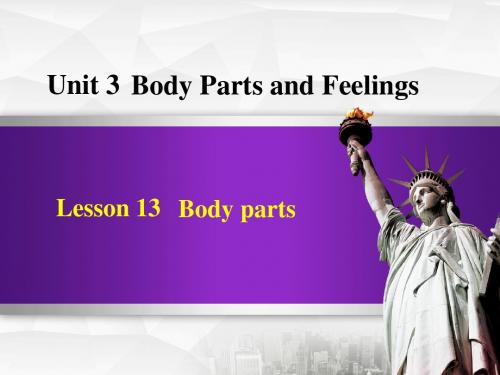
拓展 talk with/to sb.意为“和某人交谈”,talk about...意 为“谈论……”,talk with/to sb. about sth.意为“和 某人谈论某事”。
知识点 4 like/laIk/ prep.像;像……一样
eg:Like father,like son.You're also good at basketball. 有其父必有其子,你也擅长打篮球。
动词,后常跟双宾语。 笑话吧。 tell tell sb.sth.告诉某人某事。 Tell him to come here
tell sb.to do sth.告诉某人 on time.告诉他按时
去做某事。
到这儿来。
典例 “Don't ___A__ to strangers(陌生人)on your way to
【点拨】本题采用词语辨析法。with表示使用工具,in后加 某种语言或材料。句意为“我喜欢用铅笔写字。”故选A。
4. The English teacher gives us some __A______ every day. A.homework B.homeworks C.housework D.houseworks
speak 时讲某种语言、(在会上) 我不会讲日语。
发言要用speak。
意为“说;讲”,强 She didn't say anything. say 调的是说话的内容。 她什么也没说。
意为“谈话;交谈”, I want to talk to my
可用作不及物动词和 English teacher.我想和
冀教版七年级英语上册 Unit 3 Lesson 13《Body Parts》 课件

see with
用……看
write with
用……写
talk with
用……谈话
smell with
用……闻
hear with
用……听
do homework with 用……做家庭作业
make noodles with 用……做面条
Match. A
talk with see with walk with
walk with
用……走路
see with
用……看
write with
用……写
talk with
用……谈话
smell with
用……闻
hear with
用……听
do homework with 用……做家庭作业
make noodles with 用……做面条
Ask and answer.
walk with
4. He has two big feet. He can walk with them.
1
2
3
4
5
6
Robin robot
He has no ears, but he can hear us.
他没有耳朵,但能听见我们。
Listen and fill in the blanks.
1. I have two big e_y_e_s_. I can _s_e_e__ with them. 2. I have one nose and one _m__o_u_t_h_.
And describe it.
1、书籍是朋友,虽然没有热情,但是非常忠实。2022年4月23日星期六2022/4/232022/4/232022/4/23 2、科学的灵感,决不是坐等可以等来的。如果说,科学上的发现有什么偶然的机遇的话,那么这种‘偶然的机遇’只能给那些学有素养的人,给那些善于 独立思考的人,给那些具有锲而不舍的人。2022年4月2022/4/232022/4/232022/4/234/23/2022 3、书籍—通过心灵观察世界的窗口.住宅里没有书,犹如房间里没有窗户。2022/4/232022/4/23April 23, 2022
111冀教版七年级英语lesson13_body_parts

Unit 6 I Love Learning EnglishLesson 41: A Phone FriendTeaching Content:Mastery words and expressions: idea, phone, encourage, follow, repeat, sentence, understandOral words and expressions: pardon, have a good talk, have an ideaEveryday English: 1. May I speak to…? 2. This is … speaking. 3. I can’t follow you. 4. Pardon? Teaching Aims:1.How to make a telephone.2.Describe language difficulties in communications.3.Learn to write a passage with many tenses.Teaching Important Points:1.Know the time difference between China and Canada.2.How to express when you can’t follow the others.3.Oral English.Teaching Difficult Points:Use the expressions you learned in this lesson.Teaching Preparation: telephone; flashcardsTeaching Aids: audiotape; flashcardsType of lesson: new lessonTeaching Procedure:Step1: Talk about the weather with the students and ask “Who is on duty today?” Know about who is on duty next time.Step2. Introduce the topic to the class. Ask the class:1. Why should you spend so much time learning English?2. How many people speak Chinese in the world?4.How many people speak English in the world?5.Why should so many countries use English?Tell them if they don’t know the answers, it doesn’t matter. What we will learn is about the topic.Step3. Play a riddle: you answer me, although I never ask you questions. What am I? (A telephone) The teacher asks the question: Can you guess what we will learn in this text?Step4. Come to “THINK ABOUT IT!”1.How often do you make phone calls to your friends?2.Is it hard to understand your friends when they speak English? If so, what can you ask them to do?The students can answer the first question in English. If they can’t answer the second, they can answer in Chinese.Step5. Listen to the tape. Can the students answer the following questions?1.What does the girl want to do?2.When do they make a telephone? What’s the time in Canada now?3.Who wants to speak with Jenny?4.Can the girl follow Jenny when they are talking? What does the girl say then?Step6. Ask the students to read the text silently and check the answers.Step7. Divide the class into several groups. Each group has three people. Read the text in roles in class. Practice for a while then let several groups go to the front to act it out.Step8. Come to “LET’S DO IT!”Make up a dialogue with a partner. Act out a phone call between two friends. One is in China; the other is in the U.S. Try to use expressions you learned in this lesson.When the students are making the dialogue, the teacher tours the class. If they meet any trouble, try your best to help them. After five minutes, make sure they are done. Let some students act the dialogue out in front of the class.Do the others hear it clearly? Ask some questions about their passages in order to test their listening ability.Step9. 1. Finish off the activity book.2. Go on the reading in the student book.Summary:“Pardon” is a very popular expression in English when you can’t follow the others. It is useful in English classes. If the teacher takes the sentence as important spoken English, we can use it more often.Lesson 42: Welcome to the World of EnglishTeaching Content:Mastery words and expressions: language, exciting, main, meaningOral words and expressions: welcome, Mexico, Spanish, million, official, French, united, nation, United Nations, still, each other, all over the world, What do you mean by…?, official languageUseful expressions: Do you know the meaning of that sentence?Teaching Aims:1.Learn something about English.2.Encourage the students to learn English well.3.Grasp the differences in speaking and writing between Chinese and English.Teaching Important Points:1. Know about English is an official language.2.Learn about the English-speaking countries.Teaching Difficult Points:Describe why English is so important in English.Teaching Preparation: a map of the worldTeaching Aids: audiotape; flashcards; a map of the worldTeaching Procedure:Step1. Put up the map of the world on the wall. Introduce today’s topic. Let the students answer the following questions:1.Why are you learning English?2.Do you think it’s easy to learn English well?3.Which is easier, Chinese or English?4.What’s the best way to learn English?Let the students discuss the questions in groups. Then give a report to the class.Step2. Let’s learn the words from the tape. Listen to the words in this lesson for several times. Ask the students read after it and imitate. Ask some students to read the words loudly in class.Step3. Listen to the tape again and answer the following questions:1.What language is spoken in Mexico?2.How many people in the world can speak English?3.What are the main languages at the United States?4.What language is the official language of more than forty-five countries?Step4. Read the text silently and check the answers. Then let the students read the text in class. After a while, ask some students to read the text in front of the class.Step5. Retell the story, but remember not to word for word.Step6. Come to “LET’S DO IT!”In a small group, talk about why it is important to learn English. Make a poster about the importance of English and display it in your classroom.Step7. 1. Finish off the activity book.2. Go on the next reading in the student book.Summary:Let the students search the advertisements, the instructions of the things written in English and English songs before the class. The students will feel English is connected with our life closely. When we see the foreigners in the street, we will understand the importance of learning English.Lesson 43: Write a Letter in EnglishTeaching Content:Mastery words and expressions: pal, person, apartment, metre, tongueOral words and expressions: pen pal, noun. verb, I’m sorry, but… make a sentence, write to meTeaching Aims:municate with the foreigners in letters in English.2.Stimulate the students’ learning interests in the way of making pen pals.Teaching Important Points:1. How to write a letter in English.3.Have a pal from other countries.Teaching Difficult Points:Use what we learn to write a letter to a foreign friend.Teaching Preparation: some names and addresses of the foreigners; flashcardsTeaching Aids: audiotape; flashcards; some names and addresses of the foreignersType of lesson: new lessonTeaching procedure:Step1. Take out one picture of your foreign friend and show it to the students. Say: “This is my pen pal. He lives in the U. S. now. I often write letters to him. What is he like? Do you want to have pen pals, too?”The students will be very happy to have pen pals. Then let them choose one from the names and dresses of the foreigners.Step2. Listen to the words of this lesson. Let the students read after it for several times until they have correct pronunciation and intonation.Step3. Listen to the tape and answer the following questions:1.Who is Wang Mei writing to?2.How old is Wang Mei?3.Who is Jenny’s beast friend?4.What does Wang Mei teach Jessica?Step4. Read the text silently and check the answers. Then read the text loudly in class. Let some students read in front of the class. Choose who the best one is.Step5. Divide the class into small groups and let them have a further discussion.1. What is a pen pal? Do you have a pen pal?2. Where is Li Ming’s pen pal from?4.Where is Wang Mei’s pen pal from?Step6. Come to PROJECT “PEN PAL LETTERS”.Write a letter to a foreigner whom you have chosen. After they are done, let some students read their letters in front of the class. Others listen and find their grammar and selling mistakes.If some students’ have pen pals, let them bring to the school and read their letters to the class.Step7. 1. Finish off the activity book.2. Go on the next reading in the student book.Summary:Ask who has pen pals and let them bring their pen pal’s letters to the school. Read them to the class. Encourage the students to write letters in English and exchange their letters with the others.Lesson 44: Say the WordTeaching Content:Mastery words and expressions: dictionaryOral words and expressions: one more timeTeaching Aims:1.Be familiar with the rhythm of the English songs2.Cultivate the students’ interests in English through the English songs.Teaching Important Points:1.The three difficult words.2.Learn to sing the song.Teaching Difficult Points:The three long wordsTeaching Preparation: flashcardsTeaching Aids: audiotape; flashcardsType of lesson: new lessonTeaching Procedure:Step1. Something about Lesson 43.Let the students show the English letters that they searched on the Internet. Divide the class into several groups and discuss the letters. Tell the differences between Chinese and English letters. Can they read and translate the letters? Help them when they meet trouble.Step2. Ask the class to try the following tongue twister:Peter bought some butter. The butter Peter bought was bitter. So Peter bought some better butter, to make the bitter butter better.Step3. Play the tape as the students follow their books. Play the tape for several times. Let the students sing after it.Step4. Read and translate the sing by the students themselves. The teacher listens and make they are correct.Step5. Let’s sing the song together. Then sing it in rows. Let’s see which row sings the best.Step6. Ask some volunteers to sing in front of the class.Step7. Come to “LET’S DO IT”.Learning to look up the new words in dictionary is what we learn in this lesson. Make a list of the ways you use to improve your English. If you don’t understand a word, you should look it up in the dictionary.Step8: 1. Finish off the activity book.2. Go on the next reading in the student book.Summary:It has been one year since the students went to middle school. They have learned many English songs, but how many can they sing from the beginning to the end? How many English songs did they learn on the radio or on the TV? If you want to know exactly, how about having an English party? Remember: All the students and the teacher must speak English at the party.Lesson 45: Keep TryingTeaching Content:Mastery words and expressions: ago, pronounce, story, keep/stop doing, look it up in a dictionaryOral words and expressions: technique, teach…some ChineseTeaching Aims:1.The ability of reading a passage before we learn the new words.2.Learn to solve the word problems by looking up the dictionary and remember the new words accordingto their pronunciations.Teaching Important Points:1.Write a passage with many tenses.2.Know about the ways of learning English well.3.Learn to look the new words up in a dictionary.Teaching Difficult Points:Write a passage with many tenses.Teaching Preparation: flashcardsTeaching Aids: audiotape, flashcardsTeaching Procedure:Step1.1. Sing the song “Say the Word”.2. Try the tongue twister:Peter Piper picked a peck of pickled peppers. How many peppers did Peter Piper pick?Step2. Play the tape with the books closed. Let them write main points during their listening. Then ask a student to retell what the reading is about.Step3. Read the text and answer the following questions:1.Who is the girl that is speaking in the text?2.Where is she from?3.What does Teresa think is hard about learning English?4.When Teresa doesn’t know a word, what does she do?Because the reading is harder, the teacher should check the answers and explain the text when it is necessary.Step4. DiscussionSome students may think English is hard to learn. Do they think what is hard to learn English? Ask the students to make a list of the questions they met in their learning.Divide the class into several groups and find the right ways to solve the problems. Give them more time to have a further discussion.Finally the teacher can sum what they say and give them some good advice, too.Step5. Listen to the tape for several times. Let them read after it and imitate until they can read it correctly.Step6. Let some students read the text in front of the class. Encourage them to read loudly and imitate the correct pronunciation and intonation.Step7. 1. Finish off the activity book.2. Go on reading the text.Summary:This passage is about the problems that a girl met in her English learning. She has found the good ways to solve them. Some students who are weak in English may have the same problems. So in this class, the teacher should give chance to the poor students. Let them say straight and frankly. At the same time, they can improve their spoken English.Mastery words and expressions: job, around, foreign, worker, news be interested inOral words and expressions: translator, translate, translate…into…diplomat, represent, communicate, communicate with, business, programmer, computer programmer, Internet, on the Internet, international, scientist, journalist, around the worldTeaching Aims:1.Know about the importance of learning English.2.Express one’s feeling in the communication using what we learn.Teaching Important Points:1.What jobs can you do if you learn English well?2.Grasp some difficult words about jobs.Teaching Difficult Points:The oral words and expressionsTeaching Preparation: flashcardsTeaching Aids: audiotape, flashcardsType of lesson: new lessonTeaching Procedure:Step1. Talk about the future with the students. The teacher asks: “If your English is very good, what jobs would you like to do?”Show the new words to the students. Let the students read after you for several times until they can use them correctly.Step2. Continue the tongue twister:Peter Piper picked a peck of pickled peppers. A peck of pickled peppers Peter Piper picked. If Peter Piper picked a peck of pickled pepper, where’s the peck of pickled peppers Peter Piper picked?Step3. Come to “THINK ABOUT IT”.Students may see English on advertisements on the posters. At home, we can see the English instructions on almost all of the things. Ask who has seen the instructions carefully and if they can understand them.To the second question, the students can discuss and in pairs. Then make a list of the jobs and give their full reasons.Step4. Listen to the tape and think why these jobs need English. The questions are like these:1.What’s a translator? Why does a translator need English?2.What’s a diplomat? Why does a diplomat need English?3.What’s a business person? Why does a business person need English?4.What’s a computer programmer? Why does a computer programmer need English?5.What’s a Hotel worker? Why does a hotel worker need English?6.W hat’s a scientist? Why does a scientist need English?7.What’s a journalist? Why does a journalist need English?Step5. Read the text silently and check the answers. Read the text loudly in class. Then let some students read the text in front of the class.Step6. Come to “THINK ABOUT IT”.Suppose you are traveling in Beijing with your friends. If you want to take photos with a foreigner, what should you say?Now if you want to have a photo of all of you, who will take the picture? Of cause it is the foreigner. What should you say now?Step7. 1. Finish off the activity book.2. Go on the reading after class.Summary:Besides the jobs that mentioned in the text, English is used widely in many other ways. Many families have computers; nearly all the explanations are written inEnglish. If you know a little English, you will control it easily.Mastery words and expressions: article, important, program, information, encoura ge…to doOral words and expressions: America, South America, opportunity, professor, radio station, television, most, the door to the worldTeaching Aims:1.Learning English well means opening the door to the world.2.Know about the differences of writing and expressing between Chinese and English.Teaching Important Points:1.Know about the importance of learning English well.2.Inspire the students learning interest in the ways of teamwork in the class.Teaching Difficult Points:The expression: a door to the worldTeaching Preparation: English newspaperTeaching Aids: audiotape; flashcardsType of lesson: new lessonTeaching Procedure:Step1. The teacher asks the class: “Who can say a piece of news in English?”Let some students report news in English. The others listen carefully and then report it in Chinese.Step2. Ask the class “Do you know where the news is from?” Some students say it comes from North, East, West and South. So that’s why it is called news.Step3. Listen to the tape with the following questions:1.Where is John from?2.How do many people learn English?3.Why is education so important?4.What does “a door to the world” mean?Step4. Read the text silently and check the answers. Then let the students have a further discussion about the text.Step5. Let the students read the text loudly in class. Then ask some students to read the text in front of the class. The others listen carefully to make sure they have correct pronunciation and intonation.Step6. Come to “LET’S DO IT”They can find information about English language and culture in town, city and at home. Search the information and compare with your classmates. Let’s see who has a better neighbourhood.Step7. 1. Finish off the activity book.3.Go on the next reading in the student book.Summary:Search more information about English, which students can do before class. Let them bring some English newspaper to the class, too. The atmosphere makes the students happy. They also feel the importance of English in our life. Oh! We are living in a world in which English is necessary.Lesson 48: Unit ReviewTeaching Content:Mastery words and expressions in Lesson 41-48.Oral words and expressions in Lesson 41-48.Teaching Aims:1.Aim to engage students learn English well.2.Present information about the uses of English in business and professions, and the opportunities will beenlarged if you learn English.Teaching Important Points:nguage difficulties in communication.2.Past participle.nguage skills.Teaching Difficult Points:Use what we learn to express one’s feeling.Teaching Preparation: flashcardsTeaching Aids: audiotape, flashcardTeaching Procedure:Step1. Make a telephoneSuppose you are going to invite your good friend to watch a movie. Make a telephone to her and tell her the time and the place that you will meet.Remember to use the patterns: I’m sorry, I can’t follow you. Pardon? Please speak more slowly.Step2. Show the English e-mails that the students searched before the class. Write an English letter to your pen pal. Then discuss their letters in groups.Step3. Do the exercises on Page 59-60.Let them discuss the trouble they meet and help them if it is necessary. Make the students have a further discussion.Step4. Let the students summarize the grammars we learned in this unit. Discuss in groups and let’s see if it is perfect.Step5. Check the answers and explain the reasons to the students if it is necessary. Show the difficult problems on the blackboard.Step6. Finish off the activity book.If we have time, sing the song “Say the Word.”Summary:In this unit, we learn much knowledge: making a telephone, write English letter to your foreign pen pal. We should review this. Remember to spend more time on the exercises. Some are difficult and they represent much. The reasons can be given by the students or the teacher.。
冀教版-英语-七上-第13课 Body Parts 教案

Read the text and write a passage named “My body parts”.
Collect more words and expressions about body parts.
Read the passage “What is the most important part” and find good sentences.
7.教学反思
本课的教学调动了学生的多种感官,让学生动口、动手、动脑,使不同学习类型的学生都有所收获。再通过头脑风暴、小组活动、猜谜游戏、歌曲等活动激发了学生的学习兴趣,拓展了学生的知识面。
[设计思路:通过竞赛激发兴趣,通过展示音标帮学生正音。通过趁热打铁及时练习,掌握新词汇,为新授课打基础。]
Step 5 Listen and answer the questions:
1. Who is Robin?
2. Can Robin speak English and Chinese?
3. What does Danny want Robin to do?
Step 6 A Game: Read the text in group of four and try to ask more questions.
Step 7 Label Shrek's body parts.
Describe his body parts.
e.g. He has two big ears. He use them to hear the songs of the birds.
Step 3 Learn the new words.
Show the students some pictures and sentences and help them to grasp the new words.
冀教版七年级英语上册《nit 3 Body Parts and Feelings Lesson 13 Body Parts》优质课课件_5
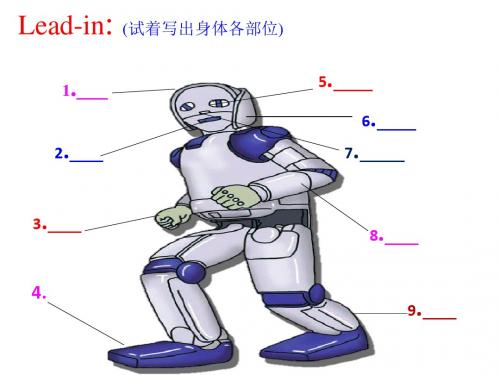
finger(s)— play game(s); feet- play football.
2. 通过介绍身体的部位,正确而灵活使用I have...;
I can ...with my...句型,对自己的相貌进行描述,
提高英语语言的综合运用能力。
3 .通过活动、游戏使学生产生学习英语的兴趣;让学生敢于、
play with 和……一起玩
Listening:
Text
Let’s Do It !
一. Read the text and fill in the blanks .
1. I have two big
eyes
.
I can see with them .
2. I have one nose and one mouth.
Robin ['rɔbin]罗宾(人名) robot ['rəubɔt] n. 机器人 camera ['kæ mərə] n. 照相机 smell [smel] v. 嗅;闻起来 finger ['fiŋɡə] n. 手指(大拇指除外) player ['pleɪə(r)] n. 比赛者;选手 homework ['həumwə:k] n. 家庭作业(不可数名词)
nose head
ear eyes
mouth
arm
leg
finger hand
foot (复数feet)
Describe his body parts.
Memorize these words quickly:
part [pɑ:t] n. 部分 feeling ['fi:lɪŋ] n 感觉;情感(常用作复数)
- 1、下载文档前请自行甄别文档内容的完整性,平台不提供额外的编辑、内容补充、找答案等附加服务。
- 2、"仅部分预览"的文档,不可在线预览部分如存在完整性等问题,可反馈申请退款(可完整预览的文档不适用该条件!)。
- 3、如文档侵犯您的权益,请联系客服反馈,我们会尽快为您处理(人工客服工作时间:9:00-18:30)。
First, describe a person, then let others guess who he/she is.
[设计思路:通过一个同学的描述,让学生猜测这个人是谁,培养学生集中注意力捕捉英语信息的能力,激发学习兴趣。]
Step 9 Listen to the song Hokey Pokey and do the actions.
Put your right hand in.
Take your right hand out.
Put your right hand in,
And shake it all about.
Do theHokey Pokey, And turn around. That’s what it’s all about.
Step 3 Learn the new words.
Show the students some pictures and sentences and help them to grasp the new words.
(设计意图:通过图片展示新词,突出重点,突破难点;通过语篇进行解释,使学生利用语境记单词和短语的含义。,让学生动口、动手、动脑,使不同学习类型的学生都有所收获。再通过头脑风暴、小组活动、猜谜游戏、歌曲等活动激发了学生的学习兴趣,拓展了学生的知识面。
Describe his body parts.
e.g. He has two big ears. He use them to hear the songs of the birds.
[设计思路:通过让学生把史瑞克的身体各部位名称进行标签,然后描述身体的各个部位,让学生初步了解如何描述身体部位。]
2.教学背景分析
教学内容分析:
教材第二单元是颜色和衣物,本单元是身体部位和感受,可以用到上一个单元用到的颜色及衣物,更清楚准确地描述人物的外貌特征。而本课主要是研究如何描述人体各部位名称及其功能。
学情分析:
七年级的孩子学习英语的积极性很高,而且这篇课文不是很难,主要问题是如何通过多种活动调动学生的多种感官,慢慢形成他们的语篇意识。
[设计思路:通过竞赛激发兴趣,通过展示音标帮学生正音。通过趁热打铁及时练习,掌握新词汇,为新授课打基础。]
Step 5Listen and answer the questions:
1. Who is Robin?
2. Can Robin speak English and Chinese?
3. What does Danny want Robin to do?
[设计思路:锻炼学生通过听力捕捉重要信息的能力。]
Step 6 A Game: Read the text in group of four and try to ask more questions.
[设计思路:通过合作学习培养学生的合作意识,通过自己提问题,培养学生用英语做事情的能力。]
Step 7 Label Shrek's body parts.
Lesson 13 Body Parts
1.整体设计思路、指导依据说明
这节课主要是学习如何用简单的英语描述外貌特征,以及通过描述身体的各部位进而描述身体各部位的功能。文章没有用真实的人物,而是用机器人Robot,增强了可读性,学生更容易接受,我在设计本课时,除了用图片及语篇引入新词外,还让学生描述动画片中的形象史莱克,激发他们的学习兴趣。
[设计思路:通过唱歌、动作,培养学生的口、手、脚的协调能力,巩固新知。]
Step 10 Dig in
1. Eye for eye and tooth for tooth.以牙还牙,以眼还眼。
2. He has a green thumb.他有特殊的园艺才能。
3. Tom likes to talk with others face to face.汤姆喜欢面对面地与别人交谈。
part, feeling, robot, camera, smell, finger, player, homework, play with
用简单的英语描述外貌特征。
教学难点:用I have .... I can do ... with my ...较为流畅地描述外貌特征。
5.教学过程设计
Step 1 Greetings:
Step 4 Remember the new words as quickly as possible. Then fill in the blanks with the new words and expressions.
Ask the students to have a competition, see which student can remember the most new words.
Collect more words and expressions about body parts.
Read the passage “What is the most important part” and find good sentences.
6.教学评价设计
Self-evaluation(自我评价):
1.我能够听懂本课语段,识别主题并获取主要信息。☆ ☆ ☆ ☆ ☆
2.我能就本课话题进行简单地交流和书面表达。☆ ☆ ☆ ☆ ☆
3.我能够勇敢地表达自己的观点。☆ ☆ ☆ ☆ ☆
4.这节课我很快乐。☆ ☆ ☆ ☆ ☆
《新课标》指出:英语课程评价体系要有利于学生综合语言运用能力的发展,采用多元化的评价方式,注重形成性评价,鼓励学生开口说英语。同时最后的自我评价,能使学生了解本课的学习效果。
4. My father and I see eye to eye on the problem.我和我爸爸在这个问题上看法一致。
[设计意图:通过知识拓展,开拓学生视野。]
Homework:
Read the text and write a passage named “My body parts”.
3.学习目标分析
1.通过观察机器人的外部构造,会用英语说出身体部位及五官的名称。
2.通过介绍身体的部位,正确而灵活使用have/has,并能对自己和他人的相貌进行描述。
3.在小组活动中,积极与他人合作,互相帮助,体会英语学习中的乐趣,遇到困难时,能主动请教,勇于克服困难。
4.教学重点、难点分析
教学重点:
Greet the students
Step 2 Warm-up: Brainstorm:
Write down as many words about body part and actions as they can. (写出关于身体部位、动作的词汇)
[设计思路:利用头脑风暴让学生以最短的时间写出关于身体部位和动作的词汇,利于后面的新知学习。]
《新课标》指出:学生通过英语课程能开阔视野,认识世界的多样性。应注重语言学习的过程,强调语言学习的实践性,主张学生在语境中接触、体验和理解真实语言,并在此基础上学习和运用
语言。鼓励学生在教师的指导下,通过体验、实践、参与、探究和合作等方式,发现语言规律,逐步掌握语言知识和技能,不断调整情感态度,形成有效的学习策略,发展自主学习能力。同时对学生进行大量的语言输入,提供丰富的课程资源,创造性地开发和利用英语学习资源,拓展学生学习和运用英语的渠道。
